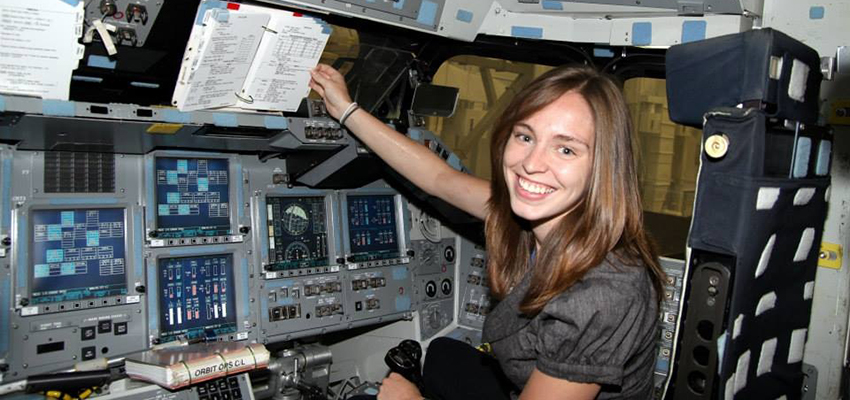Illinois State students go all over the world for summer internships. Andrea Bruck went to Mars.
Not literally Mars, but close enough: Bruck was chosen for an elite internship program that put her to work on the Mars Science Laboratory team at NASA’s Johnson Space Center in Houston working with data collected from the Curiosity rover. The senior chemistry major spent the summer studying Martian soil, searching for that holy grail of planetary science—proof of a habitable environment for life on Mars, now or in the past.
It was a 10-week experience filled with big moments. (Few college students get to see their name on an official Johnson Space Center badge.) The biggest one came when Bruck’s adviser handed to her some raw data straight from Curiosity. She’d been running experiments, but this was the real deal.
“Being able to manipulate that data, and incorporate that into my own results, and actually have a file of it—that was a humbling and almost unreal feeling for me,” said Bruck.
NASA doesn’t let just anybody analyze data from Mars. Bruck got the Lunar and Planetary Institute (LPI) internship largely because she already had extensive research experience at Illinois State, working on multiple projects under faculty mentors. Now, with her bolstered set of hard research skills and networking contacts, she plans to pursue graduate school in astrochemistry or planetary science.
Bruck’s passion for otherworldly science began when she got a job freshman year at Illinois State’s Planetarium. When you think about chemistry on Earth, there are so many scientific laws already discovered that “we have a good idea of what’s going to happen,” she said. But leave the planet, she says, and there are fewer rules and bigger questions about, say, what created that planet or that sun.
“It’s just crazy, and compelling,” said Bruck, a Streator native and past president of the Chemistry Club.
Bruck is hard working and always dependable, said Planetarium Director Thomas Willmitch, who hopes to see Bruck share her internship experience and knowledge of Mars with Planetarium audiences.
“This internship was a rare opportunity even for a graduate student in the physical sciences,” Willmitch told STATEside. “It’s somewhat unusual for an undergraduate student to do such work and is a step up in Andrea’s career—while the internship reflects what a great student Andrea is.”
Searching for evidence
Curiosity, which is about the size of a small SUV, landed on Mars in August 2012, its arsenal of instruments sending back tons more data than previous rovers. Bruck’s main job while in Houston was working with data from Curiosity’s Sample Analysis at Mars (SAM) instrument, roughly the size of a microwave. Among other things, SAM can take a sample of Martian soil, heat it up, and send data back to Earth about what gases are produced by the heat.
Bruck’s team was on receiving end of that data, searching for evidence of organics or past organics—signs of life, in other words. They would try to put a mixture of soils and salts together back here on Earth in a test bed, to try and mimic what SAM recorded on Mars.
Bruck was focused on spotting signs of oxygen. She presented her findings and plans to submit her written abstract later this year to the Lunar and Planetary Science Conference.
As one of only 14 undergraduate LPI interns—and one of only seven based at Johnson Space Center—Bruck got special tours of restricted NASA sites such as the meteorite lab, astronaut training mockup facility, and Ellington Field, the primary spaceflight training site for astronauts. Bruck also got to meet Doug Ming, one of the lead scientists on the Curiosity team, as well as three astronauts. She attended a memorial service for the late astronaut Neil Armstrong at which Buzz Aldrin spoke.
According to her adviser in Houston, Brad Sutter, one of the reasons she got the internship was because of her research experience at Illinois State. She started her sophomore year as an undergraduate research assistant working on inorganics with Department of Chemistry Professor Lisa F. Szczepura. (The senior has since joined a separate research project on meteorite analysis as well, led by Assistant Professor of Geology Tasha Dunn.)
“(Szczepura) took me from knowing absolutely nothing from working in a lab, to getting proficient in a lab, to having me be independent and a good lab worker,” Bruck told STATEside.
Happy with her research opportunities at Illinois State, Bruck applied for the elite LPI internship as a “long shot,” looking to do something she’d enjoy but couldn’t experience on campus. That internship will shine bright on her grad school applications as Bruck heads toward graduation in May.
Yet the most valuable part of the internship, Bruck says, wasn’t the cool name badges or even the access to cutting-edge Mars data. It’s how the experience changed her professional goals, away from just dreaming about a job at NASA toward something broader—her skills as a scientist, and what she’ll contribute to our understanding of the universe.
“It’s not so much where I’m going, but what I’m doing,” Bruck said.
Ryan Denham can be reached at rmdenha@IllinoisState.edu.


